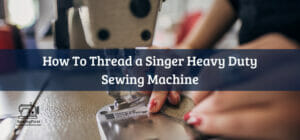Do you want to make a top without the fuss of using a sewing machine? If so, then this article is for you! In it, I’ll be exploring how you can create your own unique piece of clothing without ever having to pick up a needle and thread. With just some basic supplies, such as scissors and fabric, plus imagination and creativity, you too can make something truly amazing.
So why should you bother making clothes yourself? It’s simple: there’s nothing quite like wearing something that no one else has or seeing their reaction when they see what you’ve made.
Plus, learning new skills always feels great – especially when the end result looks incredible! And with today’s technology, creating fashionable pieces at home has never been easier.
In this article, I’m going to show you step-by-step how to make a top without a sewing machine and without needing any special equipment. So if you’re looking for ways to add some pizzazz to your wardrobe in an easy way, look no further; let’s get started!
Related Topic: How to Crop a Knit Sweater No Sewing Machine? No Problem!
Table of Contents
ToggleOverview Of No-Sew Projects
No-sew projects are a great way to get creative with fabric and make something special. It’s amazing what you can do without needing a sewing machine!
With just basic supplies, like seam allowance, fabric shears, paper pattern pieces, and excess fabric, you can create beautiful garments or accessories on any flat surface. I recently made an adorable top for my niece from some leftover cotton jersey and it didn’t take me more than 15 minutes—no needles and thread required.
The key is to find the right type of fabrics that best suit your project needs. For example, if you’re making a bag that needs to be sturdy, look for lightweight canvas or denim; if you’re working on something simple like T-shirt refashioning then knit fabrics work best. And don’t forget about fusible tape which can help secure seams in place so they won’t fray over time.
Now let’s dive into the types of fabrics perfect for no-sew projects.
Types Of Fabrics To Use
When making a top without a sewing machine, the type of fabric you choose is very important. It should be light and flexible enough to manage with just needles and thread but also strong enough for wearing regularly.
There are many different types of fabrics available on the market, from lightweight chiffon to heavier denim – it’s up to you to decide which one will work best for your project.
You can use any traditional or synthetic fabric that you would normally sew with a regular sewing machine; however, some materials may require more attention than others. For example, silk needs extra care when handling it because of its delicate nature.
Similarly, specialty fabrics such as lace might need special tools like an edge presser foot in order to make sure seams have been sewn at the correct seam allowance.
No matter what kind of fabric you choose, always ensure that it’s suitable for hand-sewing before getting started. That way, your handmade top will look professional and well-made!
Preparation Of Fabric Pieces
Now that you’ve chosen the type of fabric for your top, it’s time to get started on preparing your pieces. Believe it or not, you don’t need a sewing machine to make an awesome t-shirt! Before getting started, be sure to read all instructions carefully and lay out your work area in a way that makes sense for what you’re doing.
The first thing is to cut out each piece from the pattern. Use sharp scissors and pay close attention when cutting around curves so that the edges are nice and neat. As with any garment-making project, keep your raw edges as even as possible. This will help ensure a good finished product. Once you have all your pieces cut out, move on to stitching them together.
There are several stitch options available if you don’t have access to a sewing machine. Hand stitching can give unique texture and detail depending on how tight or lose each stitch is made. For shoulder seams use simple running stitches along both sides then tie off securely at the end once complete.
Alternatively, you could also try using adhesive tape or glue instead of hand stitching altogether – though this may limit their longevity somewhat compared to hand-stitched garments.
No matter which option suits you best for creating your top without a sewing machine, take great care throughout the entire process – measuring twice before cutting once helps save time and minimizes wastefulness too! With these tips in mind, grab your tools and materials, and let’s get crafting our handmade tops!
Tools Required For Working Without A Sewing Machine
To make a top without the use of a sewing machine, you’ll need some tools. The first and most important is a needle with a sharp point and an eye large enough to thread the color thread through it. You’ll also need scissors, a seam ripper, pins, paper clips (to hold the fabric together), or straight stitch clips.
To transfer your pattern onto the material, plain paper is best as this can be pinned directly onto the fabric without causing any damage. Then trace along the lines using the tailor’s chalk or tracing wheel and cutting mat.
Finally, you’ll need measuring tape for sizing accuracy and marking hems and darts on the garment pieces. With all these items in hand, you’re ready to start making your garments!
Techniques For Joining Fabric Together
Joining fabric together without the use of a sewing machine can be tricky, but with some patience and creativity, it’s possible. There are several techniques that you can use to join two pieces of fabric without having to resort to using a sewing machine. The most common technique is called blanket stitching, which involves looping the thread around each side of the fabric as you pull it through.
Another option is an overlock stitch, where the edges of the fabric are sewn together using stitches in a continuous line. Lastly, if you have access to a serger or overlocker then this type of machine will allow for more control over the stitching process and speed control for faster sewing speeds than hand-stitching.
No matter what method you choose, remember that joining fabrics together without a machine requires careful attention and skillful manipulation of threads and cloth. Patience is key when attempting these tasks so take your time and don’t rush yourself.
With practice comes proficiency – soon enough you’ll find yourself mastering these techniques and creating beautiful garments!
How to Make a Top Without a Sewing Machine: How To Gather Fabric
Gathering fabric for a top without the use of a sewing machine is possible! All you need are some simple materials and tools. To begin, grab your fabric and determine how much length you will need along with an outer edge that has a zigzag stitch.
Then take scissors or a rotary cutter to cut out the piece of fabric accordingly. If you don’t have either of those items, then simply fold over one side of the fabric twice before cutting along the outer edge in order to create a neat finish.
Next, pinch together two sides of the fabric about 3-4 inches apart and hold it firmly by hand. Keeping this pinched section tight and secure, start stitching up and down from end to end with a needle and thread until all parts are gathered nicely together into your desired length. Using this method you can also add as many pleats as necessary until achieving your desired look.
As an added bonus, no foot pedal or mechanical machine is required – plus there’s no automatic thread cutter needed either! So go ahead and get creative with gathering fabrics; just be sure everything remains securely pinned while stitching so nothing moves around when released at the end.
Embellishments And Decorative Elements
Now that you’ve got a basic understanding of how to gather fabric without using a sewing machine, it’s time to look at ways to add some pizzazz and flair. Embroidery machines are great for adding intricate stitch patterns or designs, but they’re not necessary if you don’t have one.
Hand stitching is just as good in most cases as long as you use the right type of thread and needles. You also won’t need an automatic needle threader since this process can be done by hand with ease.
When you get started on your project, take into consideration what kind of embellishments or decorations you’d like to include. Are there any special details that will make your top unique? Do you want to add buttons or lace trimming along the edges? It all comes down to personal preference.
Experiment with different materials and textures until something catches your eye that feels perfect for your finished product. Keep in mind though that less is often more when it comes to going overboard with extra fabrics or trims – too much excess thread can end up making things look messy instead of polished!
With these tips for creating professional-looking results, it’s now time to move on to discuss the importance of accurate measurements and cutting techniques.
Tips For Creating Professional-Looking Results
Creating a top without a sewing machine can be daunting but with the right tools and techniques, it’s possible to get professional-looking results.
To start off, you need to think about what kind of top you want to make – is it something small like a pocket or will it require larger projects such as sleeve hems? Knowing this ahead of time will help guide your choices in terms of what type of fabric and notions you should use.
If you don’t have access to higher-end machines with computerized stitching and one-step buttonholes, there are plenty of other options available. You can look for an inexpensive hand-held sewing machine or even use hem tape instead.
Both methods provide great results without the hassle of dealing with complicated machinery. If you opt for hand-sewing, consider investing in quality needles that won’t break easily during usage. This ensures better stitch formation which leads to more durable seams when finished.
No matter how well-constructed your garment is, proper finishing touches are key for creating polished looks. Ironing all pieces before assembly helps keep edges flat and smooth while also reducing wrinkles from fabric shrinkage over time.
Seam finishes prevent fraying along cut lines so they’ll stay neat after multiple washes. Taking these steps shows attention to detail which makes all the difference between homemade tops and those made by professionals! With these tips in mind, let’s move on to ironing and other finishing touches…
Ironing And Other Finishing Touches
Ironing your Basic T-Shirt is the last step of creating a top without using a sewing machine. This final touch can really make a difference in how professional and polished it looks. Here are some tips on ironing:
- Use low heat to avoid scorching or melting fabric, especially if you’re working with synthetic materials like polyester.
- Press down firmly when ironing to get crisp lines and creases.
- Iron both sides for maximum effect!
Advanced sewists may want to give their Original Shirt an extra special finish by adding trim or detailing around the neckline or hem. You can also experiment with different types of Machine Type fabrics such as lace, felt, chiffon, linen, etc., for interesting results.
Make sure that whatever type of fabric you choose is compatible with iron settings so that it doesn’t shrink or become damaged during pressing.
With these few tips in mind, you’ll have a great-looking no-sew top ready to wear! Now we will move on to exploring variations on no-sew tops that can take our wardrobe up another level of style and sophistication…
Variations On No-Sew Tops
Creating a top without a sewing machine can be quite easy and fun! There are many variations you can try if you don’t have access to modern sewing machines or computerized machines. One of the most popular ways is to use heat-seal tape.
All you need is some fabric, scissors, and an iron. This method requires no special tools other than those commonly found in households. You just cut the pieces out, arrange them as desired on your shirt, and then use an iron to press down the edges with heat-seal tape for a secure finish.
Another way to make tops without using a mechanical sewing machine is by using fusible webbing. It’s similar to heat seal tape but it has a higher strength adhesive that makes it ideal for heavier fabrics like denim or canvas material.
With this technique, all you need is two pieces of fabric, some scissors, and an iron again. Cut the fabric into the shape you want and then place one piece over another with the fusible webbing sandwiched in between them before pressing together with an iron for a strong bond that won’t come apart easily!
For more complex designs such as custom embroidery patterns or appliqués, specialized machines may be needed such as an electronic cutting device or industrial seam ripper.
However, if these aren’t available at home, there are still several options including hand stitching techniques like whipstitching which only requires basic supplies such as thread, needles, and scissors! With creative thinking and imagination, anyone can make amazing garments even without having access to expensive machinery.
How To Alter Garments Without A Sewing Machine
Altering garments without a sewing machine can seem like an impossible task. But with the right tools and techniques, you can create amazing results!
First off, you’ll need to get some supplies that will help make your alterations easier. Invest in a serger machine for quick hems and seams or purchase an extension table that allows you to use scissors instead of a full-sized sewing machine.
You’ll also need basic items such as thread, pins, needles, bobbins, bobbin holders,s and front-loading bobbins to complete your project.
Once you have all the necessary materials it’s time to begin altering your garment. Start by measuring twice and cutting only once. This is key if you want perfect results every time. Then carefully pin the fabric together at each seam before beginning any stitching process.
Next use either a hand needle or small serger stitch to securely sew pieces together making sure not to stretch out the fabric while doing so. Finally, press down on the seams using an iron or steam setting to ensure they lay flat when wearing them later on.
These simple steps are all that’s needed for successful clothing alterations without having access to a traditional sewing machine! With patience and practice anyone can learn how to alter clothes quickly and efficiently – no matter what type of fabrics are being used or design desired – giving new life back into existing wardrobe staples without breaking the bank!
Ways To Repair Clothing Without A Sewing Machine
Believe it or not, you don’t necessarily need a sewing machine to repair clothing. It may seem impossible, but there are actually several versatile methods for mending garments without the help of a machine. Irony aside, here’s how to make do without one.
The first way is using an iron-on fabric patch. All you have to do is find a patch that matches your garment and press it on with an iron. You can even get patches with designs printed on them if you want something extra special! Just be sure to place a piece of cloth over the top when pressing down so as not to damage either material.
Another great technique for fixing clothes without a sewing machine is fusing two pieces together with heat-activated adhesive tape or webbing. This works best with heavy fabrics such as denim and canvas – simply cut out the damaged area, replace with new fabric and then fuse it in place by heating up both sides of the fabric until they stick together. It’s fast, easy, and very effective!
When all else fails, there are always safety pins! Nowadays, these come in all kinds of shapes and sizes so you’re bound to find one that blends right into your outfit seamlessly. Plus, they’ll hold things in place just like stitching would – only much faster! So next time your wardrobe needs some repairs, reach for those trusty old safety pins instead of trying to locate your elusive sewing machine.
Sew-Free Alternatives To Hemming Clothing
If you don’t have a sewing machine or the time to learn how to use one, there are still other creative ways for finishing off your projects without having to sew. One of these alternatives is using adhesive hemming tape.
This product comes in multiple widths and can be used on items from lightweight fabrics like silk to heavier materials such as denim. All it takes is ironing this special double-sided tape onto your fabric and then trimming the excess material away; no skill is required!
Another great alternative is fusible webbing which also adheres to an iron. It’s perfect for making quick hems on all types of garments including jeans and skirts. As an added bonus, this type of webbing adds some extra body so that heavy fabrics drape nicely around curves instead of bunching up.
No matter what type of project you’re working on, both adhesive tapes and fusible webbings offer great options when it’s not possible (or desirable) to break out the sewing machine.
And by skipping those long hours at the sewing machine, you’ll have more time for finding inspiration for all kinds of no-sew projects! From decorating tees with paint pens to creating accessories from felt, who knows what your imagination will come up with?
Where To Find Inspiration For No-Sew Projects
Have you ever found yourself in need of inspiration for a no-sew project? If so, you’re not alone! There are plenty of ways to find fresh ideas and interesting projects that don’t require sewing machines. Here are some great places to start looking:
- Pinterest – With millions of pins, the possibilities are nearly endless when it comes to finding inspiration here. Plus, many of the images include links straight to tutorials and instructions.
- Magazines – Flip through craft magazines or fashion publications like Vogue Patterns magazine for stylish options and inventive techniques that don’t require a needle and thread.
- DIY Blogs – Dive into the blog world by searching around on Google or visiting popular crafting blogs like A Beautiful Mess or Say Yes for fun project ideas and how-to guides.
- Thrift Stores & Flea Markets–These spots can be treasure troves for finding unique fabric pieces to add an extra special touch to your projects without having to break out the sewing machine.
- Instagram – Searching hashtags is a great way to explore everything from upholstery hacks using tape instead of stitches, to handmade tassels made with embroidery floss.
There’s also something really satisfying about creating something new from things you already have lying around your home—like old sheets or pillowcases that could become curtains or slipcovers—so keep an eye out for everyday items that might make perfect materials for clever crafting projects.
Now that we’ve gathered up some fabulous sources of inspiration let’s move on to safety considerations when crafting without a sewing machine…
Safety Considerations When Crafting Without A Sewing Machine
Now that you’ve found some inspiration for your no-sew projects, let’s take a moment to consider the safety aspects of crafting without a sewing machine. It’s important to remember that when engaging in any kind of craft project – especially one with sharp tools or materials – it pays to exercise caution and common sense.
First off, make sure you have good lighting so you can clearly see what you’re working on. This is especially true if scissors are involved!
You also want to keep all tools away from small children, pets, and other distractions while you’re working. If something could potentially cause harm if handled improperly, then it should be put away until after the project is complete.
Finally, wear protective gear when necessary such as gloves or goggles if dealing with hot glue guns or hazardous chemicals.
Additionally, try not to use too much pressure during cutting operations; instead, opt for light cuts and steady hands. By taking these precautions into account, you’ll enjoy a safe (and hopefully successful!) crafting experience regardless of whether or not there’s a sewing machine nearby!
Conclusion
In conclusion, crafting without a sewing machine is an incredibly rewarding experience. It can be a great way to save money, exercise creativity, and make unique pieces of clothing or home decor.
Crafting with no-sew projects is like painting on a blank canvas – the possibilities are truly endless. Whether you’re repairing clothes, making something new from scratch, or finding inspiration online, there’s always something fun waiting for us when we craft without a sewing machine!
So why don’t you give it a try? You may surprise yourself with what amazing things you can do without ever needing to use a sewing machine! Who knows – you could end up becoming the next DIY sensation!
FAQs
Can you sew clothing without a sewing machine?
Yes, you can sew clothing without a sewing machine. Hand sewing is a traditional method of sewing that is still used today. It is a slower process than machine sewing, but it allows for more intricate stitch patterns and allows for a greater degree of control.
How do you make a crop top without a sewing machine?
There are several ways to make a crop top without a sewing machine. You can use fabric glue to attach the pieces of fabric together. You can also use hand stitching to sew the pieces together. You can also use bias tape to bind the edges of the fabric together. Finally, you can use fabric scissors to cut the fabric into the desired shape and then use fabric glue or hand stitching to put it all together.
What can I use instead of a sewing machine?
You can use a needle and thread to hand-sew your project instead of using a sewing machine. Other alternatives include using fabric glue, fusible bonding tape, iron-on patches, and other types of fasteners.
What is the easiest thing to sew clothes?
The easiest thing to sew clothes is a simple pillowcase dress. It requires only a few seams and can be finished in a short amount of time.
How do you make crop tops with scissors?
1. Choose a t-shirt that fits you and fits your style.
2. Lay the t-shirt flat on a table or other flat surface.
3. Measure and mark the desired length for the crop top.
4. Cut around the marked area with sharp scissors.
5. Cut fringes on the bottom of the crop top if desired.
6. Try it on and make any adjustments needed.
What can I sew at home?
You can sew a variety of items at home, including clothes, pillows, tote bags, curtains, quilts, and more. You can also create your own patterns and designs to make something truly unique.
What is the easiest clothing to make?
The easiest clothing to make is a t-shirt. All you need are two pieces of fabric, sewing supplies, and a pattern. With just a few simple steps, you can make a basic t-shirt in no time.





